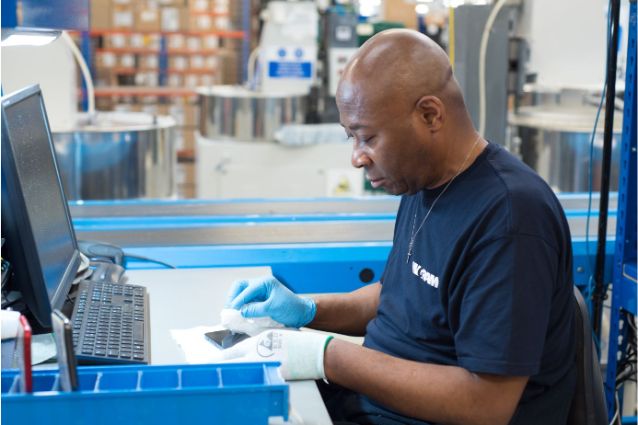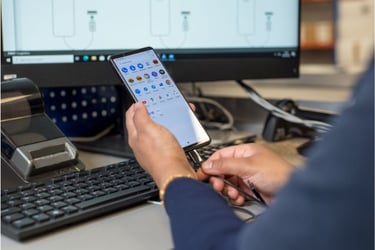Are you facing a high volume of mobile phone returns from consumers and want to understand what the causes are?
There are myriad reasons why consumers can choose to return their mobile phones. Every return increases the cost to the retailer or the network operator. The more returns you process, the higher the cost implications are.
Understanding the reasons why returns occur in the first place can help you mitigate these.
Did you know that three times as many products are returned from e-commerce sales (30%) compared to bricks and mortar sales (8.89%)? When shopping online, 67% of consumers check the returns policy before purchasing, as this influences their purchase decisions.
Ingram Micro Lifecycle manages technology product returns for many reputable household brands. These include mobile network operators and OEMs (Original Equipment Manufacturers).
Below, we’ll discuss the reasons why consumers return their mobile phones to the retailer or network operator they purchased them from.
Why returns can be a problem
40% of consumers have admitted to taking a "bracketing" approach when buying devices from e-commerce sites. Bracketing refers to the practice of ordering multiple sizes and colors of the same product at once.
The consumer always intends to return the majority of these but orders multiples so they can return what doesn’t fit or suit them.
New consumer electronics, such as mobile phones, are creeping up in cost. It’s unlikely that consumers would buy multiple as the upfront cost and commitment would be higher. But this is a case of returns abuse. This is something that retailers and network operators of mobile phones will experience.
Processing refunds is an extra cost to your outgoings. Graded, repaired, and rekitted returns can be resold to recover some costs. These will have a lower value than the original sales price as they’re in a used condition.
This process takes up time and extra resources too.
14 reasons consumers return mobile phones
As a 3PL provider for technology customers, these are the top reasons we see behind mobile phone returns. We include both legitimate and fraudulent reasons below.
1. The customer ordered the wrong product
Any issue with the consumer ordering the wrong item is likely to be unintentional. For example, they could’ve ordered the wrong model, memory size, or color.
2. Shipped the wrong product
Human error or a fault in the matrix when readying the product for dispatch can cause this.
3. The product wasn’t what they expected
Customers may try to use the device with a preconception of how it will perform. The reality doesn’t always meet their expectations.
This can happen when a customer switches phone operating systems. For example, from Apple iOS to Android, or vice versa. It can also happen when customers switch between manufacturers of other product categories.
4. Rethinking the cost
In hindsight, sometimes the cost outweighs the real need for the product. The consumer experiences buyer’s remorse and sends the phone back.
5. Actual or perceived fault
There may be a technical issue with the mobile phone. More often, the customer has difficulty using a specific function.
Damage may have occurred during shipping. It's time to review your packaging and logistics partner if this is a regular occurrence.
Up to 80% of product returns have been reported as broken or damaged.
This is where returns avoidance diagnostics help lower return numbers.
6. Unwanted gift
It can be a well-meaning gesture to buy someone a gift, especially if it’s a high-end mobile phone. Sometimes, the gesture doesn’t pan out as expected, especially around Christmas time.
Store credit, anyone?
7. Cheaper elsewhere
It’s so easy to whip out your phone and check prices online. We’ve all done it. We’ve all been in a store and browsed other retailers to see who has the most competitive pricing.
It’s the same for influencing a mobile phone return.
The consumer buys the phone and the next day gets an email to say the product is on offer through another retailer. Or there’s a more attractive package deal that’s become available on the model they already bought.
They take up the more appealing offer and return the device they paid full price for. They know the return can be hassle-free, no questions asked.
8. Loopholes in returns policies
With a view of improving customer satisfaction, these often make it easy to return goods with low effort required by the consumer. 'Returns abuse' is where customers continue to exploit the policy.
Over 40% of electronics retailers reported that up to 10% of returns made were abusing the returns policy.
The gesture of goodwill could lead to inflated volumes of returns.
Continue learning: 7 Ways a Returns Policy Influences Consumer Behavior
9. Late delivery or item no longer needed
This may be through no fault of your own. The consumer could’ve ordered too late, or there could’ve been delays with the delivery partner.
If a new phone is for a special occasion, and the item isn’t delivered until afterward, the consumer may have bought a replacement elsewhere.
Consumer dissatisfaction with the delivery time could make them buy elsewhere.
Fraudulent returns
While these make up a minority of returns, we can’t ignore the fact that they do happen. Here are five fraudulent reasons that may be behind customer returns.
10. Money laundering or shoplifting
Money laundering occurs when a customer buys a product on a stolen credit card and tries to get a refund in cash.
Always make sure to process any refunds onto the same card used in the transaction or give in-store credit.
Shoplifters could request a refund on stolen goods. No receipt, no refund.
11. “Damaged” goods
Following point 5 above, not all reported damages may be legitimate. A customer could file a complaint to say that the product arrived damaged. You ship out a replacement or issue a refund.
The reality may be that the product they received was in perfect condition. This means they get the original phone or a replacement for free.
There’s also the consideration of where the damage occurred. Could it be that the customer damaged the product but is making the claim on your returns policy?
12. Unable to resell
Bulk devices ordered on credit may be resold for an inflated price. This is more likely when a handset may be in high demand in your area, or retailer stock is running low.
Scalpers buy up whatever stock they can, ready for resale at an increased price.
They return anything to you that they’re unable to sell or make a profit on for a refund.
13. Switched goods
A strange story online details one consumer who bought a brand-new iPhone. They returned the product soon after for a full refund. The box was in pristine condition so no one asked many questions. The consumer kept the device and boxed up a potato instead.
Rather than a potato, you may find that it’s a different model in the box or the customer’s old phone.
Another example of this is a YouTuber who purchased a $6,000 camera. On opening the sealed camera packaging, he discovered a box of rocks. The retailer replaced the item but it happened again, with bricks in the box instead.
14. Bricking
"Bricking" is the process of stripping products of components before returning them for a refund. The returned product is useless, but the fraudster has kept components for use elsewhere.
In this case and point 13, the missing product or components are replaced with something of similar weight. Any automatic weighing of the return doesn’t detect a change in the product.
This poses a risk to your brand integrity if you supply products that are missold because you didn't check them properly.
It also causes stress for the new customer as they try to prove they received the item in that condition.
Lower your returns rate and recover value today
A good returns partner adds value through swift processing and rekitting of returned smartphones. They’ll conduct thorough testing, grading, and non-intrusive cosmetic grade uplift. Ultimately, devices become ready for resale or re-use.
Their experience and refined processes will quickly get the device back out for resale, enabling the highest value recovery possible. This will release you of the burden of having these products on your balance sheet.
Ingram Micro Lifecycle offers this as part of our commitment to enabling a circular economy for our customers. To date, we haven’t found any potatoes in returned packages. Reach out to us today to discuss your current returns program and how we can save you money.
Network operators may find our checklist for a successful technology returns program useful.
Related articles:
- How quickly do smartphone returns depreciate? 5 key factors
- Techniques for uplifting value on returned products
- What is nomophobia and the impacts on returns management?
- Reverse logistics opportunities to transform returns into revenue (Report)
- The importance of returns management, recovery, and recommerce
- 7 reasons why consumers are switching from new to refurbished devices













